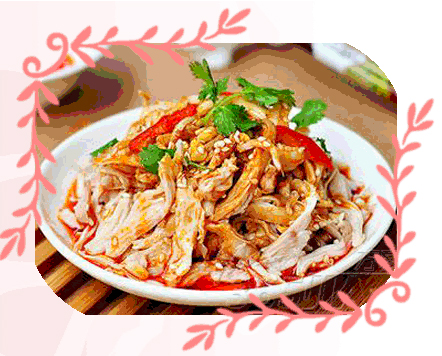Stick-beaten chicken shreds
Updated: 2012-03-12 16:17
(chinaculture.org)
|
|||||||||||

This is one of the well-known Sichuan local dishes that originated before the Ming Dynasty (1368-1644) in a small town named Hanyang by the Mingjiang River in the present Qingshen County, Sichuan Province. A chef created the dish by boiling chicken first, then beating with a stick till spongy. Then he tore the chicken meat into shreds, which was seasoned with spices. The dish features a spicy flavour and tender texture, which is popular among local people. Now, the dish is also served in Sichuan food restaurants in big cities like Beijing and Shanghai. In recent years, many visiting overseas Chinese and foreign guests have tasted it and they are enchanted by its unique way of cooking and its uncommon nice flavour.
Ingredients:
Chicken breast or leg 250g
Sesame paste 5g
Scallion 5g
Red chili oil 10g
Sugar 2.5g
Soy sauce 15g
MSG 0.5g
Chinese prickly ash 0.5g
Seasame oil 1.5g.
Preparation:
1. Boil the chicken breast or leg for about 10 mimutes until fully cooked. Remove from heat and let cool. Beat with a club so that the meat becomes spongy. Tear the chicken meat into shreds and put on the plate. Sprinkle on some scallion slices.
2. Make seasoning in a bowl with soy sauce, sesame paste, chilli, sugar, MSG, Chinese prickly ash and seasame oil. Add this to the chicken shreds and mix well.
Today's Top News
Rescuers race against time for quake victims
Telecom workers restore links
Coal mine blast kills 18 in Jilin
Intl scholarship puts China on the map
More bird flu patients discharged
Gold loses sheen, but still a safe bet
US 'turns blind eye to human rights'
Telecom workers restore links
Hot Topics
Lunar probe , China growth forecasts, Emission rules get tougher, China seen through 'colored lens', International board,
Editor's Picks

|

|

|

|

|

|





